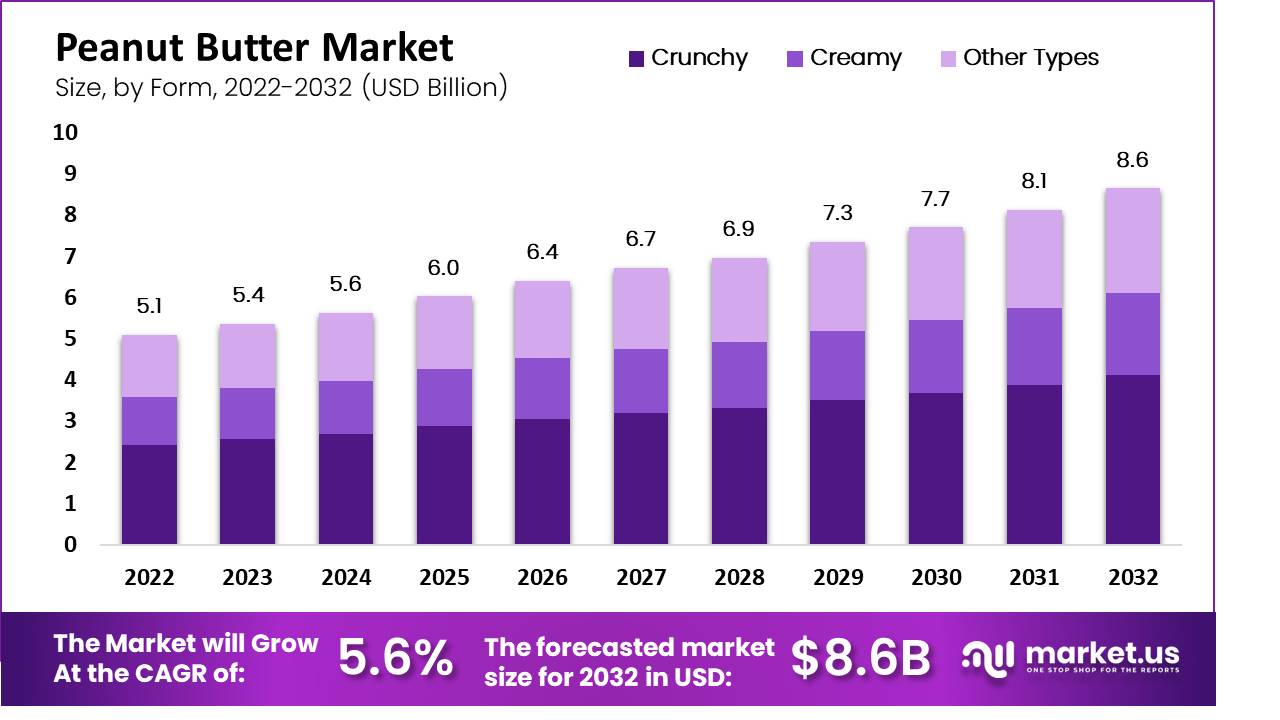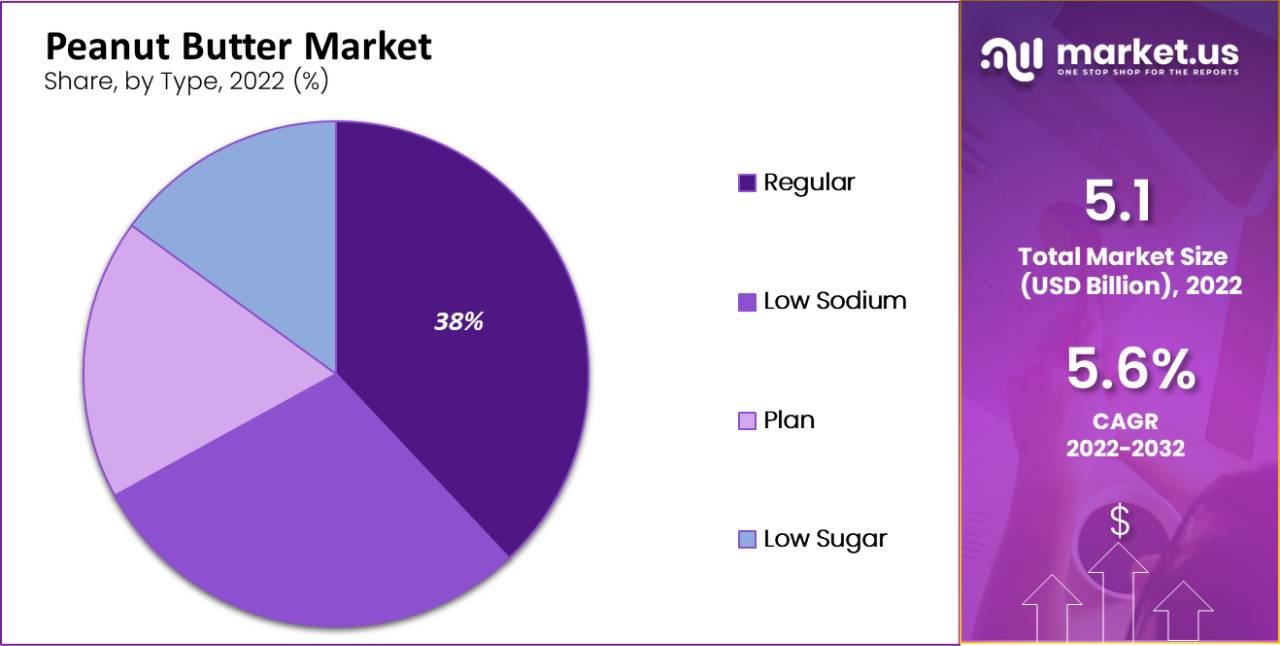Table of Contents
Introduction
According to Peanut Butter Statistics, Peanut butter, a well-loved spread globally, is primarily derived from finely ground roasted peanuts and may contain additives like salt, sweeteners, and emulsifiers. It supplies crucial nutrients such as protein, healthy fats, fiber, vitamins, and minerals.
Found in creamy, crunchy, natural, and organic forms, it is versatile and can serve various culinary purposes, including spreading, dipping, or cooking.
Its health benefits include serving as a valuable source of plant-based protein and heart-healthy fats, aiding digestion, and providing antioxidant properties.
Properly storing peanut butter in a cool, dry environment is essential to preserve its freshness and prevent spoilage.
Editor’s Choice
- The global peanut butter market will reach $8.6 billion by 2032.
- Regular peanut butter holds the largest share at 38%, indicating its widespread popularity among consumers.
- France emerged as the leading importer in 2022, with an import value of USD 148.21 million, constituting approximately 9.81% of the total import value.
- India leads the export volume with a substantial shipment volume of 31,328 units, demonstrating its significant global market presence.
- China stands out as the leading consumer, consuming a significant 4210 TMT in 2023, more than double the amount consumed by India, the second-largest consumer at 1494 TMT.
- In July 2023, the average export price reached $2,062 per ton, marking a slight increase of 1.6% compared to the previous month.
- According to the latest survey from Ask Your Target Market, most respondents, accounting for 76%, expressed a generally favorable opinion.

Global Peanut Butter Market Overview
Global Peanut Butter Market Size
- The global peanut butter market has demonstrated consistent growth in revenue over the years at a CAGR of 5.6%, reflecting its enduring popularity among consumers worldwide.
- Starting at $5.1 billion in 2022, the market revenue increased steadily to $5.4 billion in 2023 and $5.6 billion in 2024.
- The market is forecasted to expand further, reaching $8.6 billion by 2032.

Peanut Butter Market Size – By Form
- The global peanut butter market, segmented by form, has shown consistent growth in revenue across different types over the forecast period.
- In 2022, the total market revenue stood at $5.1 billion, with crunchy peanut butter generating $2.43 billion, creamy peanut butter at $1.17 billion, and other types contributing $1.49 billion.
- The revenue from crunchy peanut butter increased steadily from $2.58 billion in 2023 to $4.10 billion in 2032.
- Similarly, revenue from creamy peanut butter grew from $1.24 billion in 2023 to $1.98 billion in 2032.
- Revenue from other types of peanut butter also saw significant growth, reaching $2.52 billion in 2032.

Global Peanut Butter Market Share – By Type
- The regular category holds the largest share at 38%, indicating its widespread consumer popularity.
- Following closely behind is low-sodium peanut butter, capturing 29% of the market share, appealing to health-conscious consumers seeking reduced sodium options.
- Plant-based peanut butter accounts for 18% of the market share, reflecting the growing trend toward plant-based diets.
- Lastly, low-sugar peanut butter holds a 15% market share, catering to consumers looking for alternatives with reduced sugar content.

Peanut Butter Import Statistics
- In 2022, the global import statistics revealed a distribution of significant import values across several countries.
- France emerged as the leading importer with an import value of USD 148.21 million, constituting approximately 9.81% of the total import value.
- Not far behind, the United States followed closely with an import value of USD 147.24 million, comprising 9.75% of the import value.
- Japan and Germany also contributed notably to the import landscape, with import values of USD 108.23 million and USD 106.1 million, respectively, accounting for 7.16% and 7.02% of the total import value.
- Canada and the United Kingdom also maintained substantial shares, with import values of USD 85.31 million and USD 79.26 million, representing 5.65% and 5.25% of the total import value, respectively.

Peanut Butter Export Statistics
- Peanut butter export statistics reveal notable trends across various countries.
- India leads the pack with a substantial shipment volume of 31,328 units, demonstrating its significant global market presence.
- Following closely behind, the United States and the Netherlands stand out with 14,441 and 14,010 shipments, respectively, showcasing their robust export capacities.
- South Africa emerges as another key player, contributing significantly with 12,881 shipments.
- Germany and Poland also exhibit notable export figures, with 11,345 and 10,208 shipments respectively.
- The United Kingdom, France, Italy, and Spain maintain respectable export volumes ranging from 5,952 to 5,209 shipments, indicating their international trade participation.

Global Consumption of Peanut Butter
- China stands out as the leading consumer of peanut butter, consuming a significant 4210 TMT in 2023, more than double the amount consumed by India, the second-largest consumer at 1494 TMT.
- Following these two countries, consumption drops notably in other parts of the world. For instance, Myanmar consumed 309 MT, while Sudan and Nigeria consumed 255 MT and 245 MT, respectively.
- Tanzania and Burkina Faso consumed 170 MT and 153 MT, respectively.
- The United States consumed 152 MT, slightly edging out Brazil’s consumption of 148 MT.
- In contrast, some countries had minimal consumption in 2023, such as Japan with 1 TMT, Mexico with 2 MT, and Zambia with 3 MT.
- Togo and Guatemala each consumed 5 MT, while South Africa, Taiwan, Gambia, and Turkey consumed 6 MT, 7 MT, and 8 MT, respectively.
Cost of Peanut Butter
- In July 2023, the average export price reached $2,062 per ton, marking a slight increase of 1.6% compared to the previous month.
- Overall, the export price exhibited a relatively stable trend over time. The most significant growth rate occurred in August 2022, with a month-on-month increase of 13%, reaching a peak of $2,338 per ton.
- However, average export prices remained lower from September 2022 to July 2023. Prices varied significantly depending on the destination country, with Afghanistan having the highest price at $3,247 per ton, while Turkey had one of the lowest average export prices at $1,653 per ton.
- From July 2022 to July 2023, the most notable price increase was observed in exports to Turkey (+2.3%), while prices for other major destinations experienced more modest growth rates.
- According to information from the U.S. Bureau of Labor Statistics, the cost has increased by nearly 94% between 1997 and 2024, which equals about a $2.33 increase in price.
- Right now, the average national price for a pound of creamy peanut butter is about $2.48, although this can vary depending on where you are in the country due to how the data is collected.
Nutritional Value of Peanut Butter
- Peanut butter is a rich source of various nutrients. In terms of proximates, it contains 1.18 grams of water and provides 597 calories per serving.
- It is high in protein, with 22.5 grams per serving, and contains a significant amount of fat, totaling 51.1 grams.
- Regarding carbohydrates, it contains 22.3 grams of carbohydrates, including 4.8 grams of dietary fiber and 10.5 grams of total sugars.
- It also provides various minerals such as calcium (49 mg), iron (1.73 mg), magnesium (169 mg), phosphorus (339 mg), potassium (564 mg), sodium (429 mg), zinc (2.54 mg), copper (0.42 mg), and selenium (4.1 µg).
- Additionally, it contains several vitamins and other components, including thiamin (0.138 mg), riboflavin (0.191 mg), niacin (13.3 mg), vitamin B-6 (0.444 mg), folate (86 µg), choline (63 mg), and vitamin E (9.11 mg).
Consumer Trends and Preferences
Flavours and Brands
- According to the latest survey from Ask Your Target Market, most respondents, accounting for 76%, expressed a generally favorable opinion.
- Only 6% indicated dislike, while 18% remained neutral.
- Among the various types, the creamy emerged as the most favored, with 68% of respondents selecting it as their favorite.
- In comparison, 22% preferred crunchy peanut butter, while 9% favored extra crunchy.
- Additionally, 1% mentioned other favorite types, such as all-natural or a combination of creamy and crunchy.
Food Pairings
- People have plenty of ways to enjoy this. Most folks, about 76%, love classic peanut butter sandwiches.
- Then there’s a good chunk, around 36%, who enjoy cookies or bakery goods.
- Another 29% have a sweet tooth and prefer it in candy—some, about 26%, just like it straight from the jar.
- For others, around 14%, it’s all about adding it to shakes or smoothies.
- And there’s a small group, about 10%, who get creative with peanut butter, like using it in sauces or pairing it with apples and celery.
Alternative Options
- For individuals allergic to peanuts or seeking alternative options, many substitutes exist to explore.
- About 31% of respondents favor apple butter, while 28% enjoy almond butter.
- Hazelnut butter is liked by 22%, followed by cashew butter at 17%.
- Additionally, 14% opt for cookie butter, while 4% prefer soy butter.
- Other alternatives, like sun butter made from sunflowers, are favored by 3% of respondents.
- Nutella emerged as the most popular choice among the mentioned brands for peanut butter alternatives.
Discuss your needs with our analyst
Please share your requirements with more details so our analyst can check if they can solve your problem(s)



